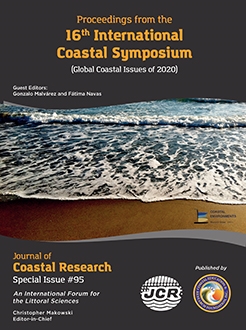Xu, H.-J,; Huang, Z.; Bai, Y., and Bai, Y.-C., 2020. Effects of flow circulations on the sediment dynamics in the Deep-water Navigation Channel of the Yangtze River Estuary. In: Malvárez, G. and Navas, F. (eds.), Global Coastal Issues of 2020. Journal of Coastal Research, Special Issue No. 95, pp. 723a-727a. Coconut Creek (Florida), ISSN 0749-0208.
In this paper, a two-dimensional model is established to estimate the hydro-sediment dynamics in the Deepwater Navigation Channel of the Yangtze River Estuary by calculating the flow field and sediment deposition. The results show that the circulation is mainly caused by shear stress of the flow in the main channel during the maximum flood and ebb tides and that at these times, the circulations are small and close to the groyne roots. At the slack tides, the water level gradient is an indispensable factor, and the circulations are relatively larger and located in the center of the groyne fields. The spatiotemporal characteristics of the sediment dynamics are considered closely related to the flow circulations. Specifically, the flow circulations inhibit the scouring of the groyne fields because these circulations form areas with low flow velocities and an enclosed environment that prevents powerful flow of the deep-water channel into the groyne fields. The results will provide effective support for the safe operation of the Deep-water Navigation Channel in the Yangtze River Estuary.





